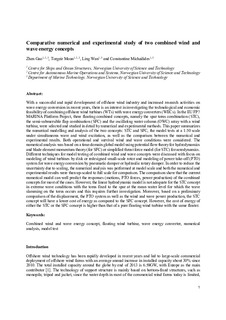| dc.contributor.author | Gao, Zhen | |
| dc.contributor.author | Moan, Torgeir | |
| dc.contributor.author | Wan, Ling | |
| dc.contributor.author | Michailidis, Konstantinos | |
| dc.date.accessioned | 2017-10-16T08:30:43Z | |
| dc.date.available | 2017-10-16T08:30:43Z | |
| dc.date.created | 2015-12-16T15:51:34Z | |
| dc.date.issued | 2016 | |
| dc.identifier.citation | Journal of Ocean Engineering and Science. 2016, 1 (1), 36-51. | nb_NO |
| dc.identifier.issn | 2468-0133 | |
| dc.identifier.uri | http://hdl.handle.net/11250/2460218 | |
| dc.description.abstract | With a successful and rapid development of offshore wind industry and increased research activities on wave energy conversion in recent years, there is an interest in investigating the technological and economic feasibility of combining offshore wind turbines (WTs) with wave energy converters (WECs). In the EU FP7 MARINA Platform project, three floating combined concepts, namely the spar torus combination (STC), the semi-submersible flap combination (SFC) and the oscillating water column (OWC) array with a wind turbine, were selected and studied in detail by numerical and experimental methods. This paper summarizes the numerical modeling and analysis of the two concepts: STC and SFC, the model tests at a 1:50 scale under simultaneous wave and wind excitation, as well as the comparison between the numerical and experimental results. Both operational and survival wind and wave conditions were considered. The numerical analysis was based on a time-domain global model using potential flow theory for hydrodynamics and blade element momentum theory (for SFC) or simplified thrust force model (for STC) for aerodynamics. Different techniques for model testing of combined wind and wave concepts were discussed with focus on modeling of wind turbines by disk or redesigned small-scale rotor and modeling of power take-off (PTO) system for wave energy conversion by pneumatic damper or hydraulic rotary damper. In order to reduce the uncertainty due to scaling, the numerical analysis was performed at model scale and both the numerical and experimental results were then up-scaled to full scale for comparison. The comparison shows that the current numerical model can well predict the responses (motions, PTO forces, power production) of the combined concepts for most of the cases. However, the linear hydrodynamic model is not adequate for the STC concept in extreme wave conditions with the torus fixed to the spar at the mean water level for which the wave slamming on the torus occurs and this requires further investigation. Moreover, based on a preliminary comparison of the displacement, the PTO system as well as the wind and wave power production, the STC concept will have a lower cost of energy as compared to the SFC concept. However, the cost of energy of either the STC or the SFC concept is higher than that of a pure floating wind turbine with the same floater. | nb_NO |
| dc.language.iso | eng | nb_NO |
| dc.publisher | Elsevier | nb_NO |
| dc.title | Comparative Numerical and Experimental Study of two Combined Wind and Wave Energy Concepts | nb_NO |
| dc.type | Journal article | nb_NO |
| dc.description.version | submittedVersion | nb_NO |
| dc.source.pagenumber | 36-51 | nb_NO |
| dc.source.volume | 1 | nb_NO |
| dc.source.journal | Journal of Ocean Engineering and Science | nb_NO |
| dc.source.issue | 1 | nb_NO |
| dc.identifier.doi | 10.1016/j.joes.2015.12.006 | |
| dc.identifier.cristin | 1301801 | |
| dc.relation.project | Norges forskningsråd: 223254 | nb_NO |
| dc.relation.project | Norges forskningsråd: 237929 | nb_NO |
| dc.description.localcode | This is a submitted manuscript of an article published by Elsevier in Journal of Ocean Engineering and Science, 29 January 2016 | nb_NO |
| cristin.unitcode | 194,64,20,0 | |
| cristin.unitname | Institutt for marin teknikk | |
| cristin.ispublished | true | |
| cristin.fulltext | preprint | |
| cristin.qualitycode | 1 | |
